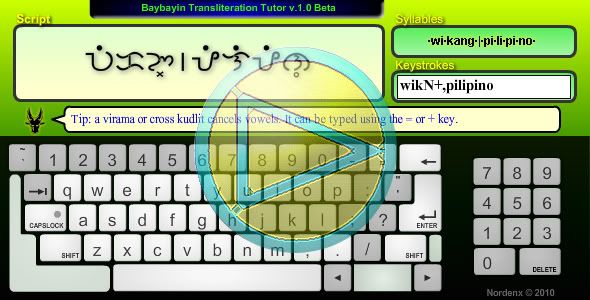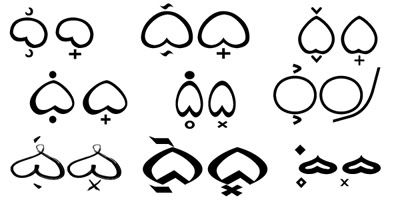Learning the Kapampangan style of baybayin.
Súlat Kapampángan (a.k.a.
pámagkulit, kulitan) has been kept alive by loyal practitioners, but for a long time it was only limited to the elite few - the scholars, intellectuals, and advocates. It is currently on a sort of revival with local youths, thanks to recent publications, several active organizations in universities in the
Philippines, local artists, and the Internet. However, the
Doctrina Christiana based
Tagalog (sans-
virama) and Ilocano (w/
virama) versions of baybayin are more prevalent with
Filipinos outside of the Philippines. This is due to the proliferation of sites that are a dedicated to "traditional" baybayin in that style, not to mention a larger population of Tagalog/Ilocano speakers and their third-generation (Fil-Am, Fil-Canadian, etc.) children who are rabidly searching for their roots and holding on to heritage.
Garlit at Kudlit
"Garlit" is the Kapampangan term for "Kudlit" (dot or stroke diacritic marks) and
Súlat Kapampángan use the top & bottom kudlit to change each consonant character's default "a" sound to the basic "i" and "u" respectively, just like other versions of baybayin. But unlike the "traditional" baybayin,
Súlat Kapampángan has a way to change the "i" and "u" sounds to "e" and "o" as well as lengthen the "a", "i", and "u" sounds:
- To render an "e", write the character (not the kudlit) for "I" next to the consonant.
- To render an "o", write the character (not the kudlit) for "U" next to the consonant.
- To lengthen the "a" sound, write the character for "A" next to the consonant.
- To lengthen the "e" sound, write the character (not the kudlit) for "I" next to the consonant that already has an "i" kudlit.
- To lengthen the "u" sound, write the character (not the kudlit) for "U" next to the consonant that already has an "u" kudlit.
These methods work particularly well with the
Kapampangan language since their "o" and "e" vowels are conversions of diphthongs to monophthongs, but it may be cumbersome if not confusing to other Filipinos who are mainly used to Tagalog, particularly the Filipinos born outside of the Philippines whose proficiency with other
Filipino language is mediocre at best, let alone having an ear for the accents of native languages.
The Kapampangan language does not use the "H" sound except in loan words, naturally
Súlat Kapampángan does not have a glyph for "Ha". It also doesn't have characters for the "W" and "Y" sounds, instead the glyph for "U" represents the "W" sound and the glyph for "I" is used for the "Y" sound. Furthermore, "Wa" is rendered by combining the "U" & "A" characters, while "Ya" is rendered by the combination of "I" and "A" characters. Also, to render a standalone "E", ligatured glyphs "A" & "I" are used; and to get a standalone "O", use the combination of "A" & "U" glyphs.
Virama, who needs yah?!
Forming consonant conjuncts by creating compound character ligatures is a method where trailing consonants (consonants without vowel sounds at the end of a syllable) can be written without using a
virama (vowel cancellation mark) in order to render dead consonants in
Súlat Kapampángan. Just like the virama, this method is adopted from other
Brahmic scripts, and this method is also observed and recorded on the oldest artifact that bears Kawi (Old Javanese) and a proto-baybayin form of writing; the
Laguna Copperplate Inscription (
LCI).
When writing horizontally (an alternative way), to remove the default vowel from a consonantal character, its glyph is stacked under its preceding "main" syllable character.
When writing vertically (preferred and considered traditional), to remove the default vowel from a consonantal character, its glyph is placed at the right of its preceding "main" syllable character.
Different ways to kill a vowel (and leave a dead consonant):
The Kapampangan method can be quite beautiful when used for typographic arts such as logos, tribal tattoos, calligraphy, etc. And if you're opposed to using the Spanish addition of a cross kudlit or any form of virama mark but still want to render trailing consonants (leading consonants is another story), then feel free to use the Kapampangan version of baybayin.
Caveat lector—
While the Kapampangan method has its advantages with a wider range of vowels and its ability to render trailing consonants, it is perfect for writing the Kapampangan language. However, it has its limitations when it comes to standardization or modern typeface design and word processing as well as rendering non-Kapampangan or foreign loan words. Legibility is often compromised when writing vertically, since stacking a character with a kudlit over another tends to confuse readers as to which glyph the kudlit belongs to, especially when spacing between characters are too close.
Súlat Kapampángan characters' evolution appeared to have diverted from other baybayin scripts through time since the 17th century. A 1699 publication,
"El Arte de lengua Pampanga" by Alvaro de Benavente shows Kapampangan characters that are still very similar to the Ilocano script characters recorded in the 1620
Doctrina Cristiana with only slight variations on a couple of characters. Benavente's script also bears much resemble to the current living Tagbanua script from Palawan. Comparison of Benavente's script to the scripts recorded in recent publications from the 1960's up to 2008 by the likes of Zoilo Hilario, Mariano Henson, and Michael Pangilinan, et al. shows how cataloging handwriting changed the glyphs dramatically. And it is not just stylistic changes but the basic form of several Kapampangan characters have totally deviated from the Tagalog/Ilocano versions of baybayin. Couple these changes with the unique (vertical - top to bottom direction) method of writing,
Súlat Kapampángan is in a class of its own. Another Philippine script that evolved similarly is Bikol's
Basahan script (that's another story).
See sample images here:
www.siuala.com
Emulating the Kapampangan writing method using "traditional" Tagalog/Ilocano baybayin characters could be a sensitive issue. On one hand we do not want to offend regional sensibilities, on the other hand imitation is the purest form of flattery. We should be proud and thankful that Kapampangans kept their script alive as did the Mangyans of Mindoro and the Tagbanua of Palawan. Indeed we need to look back to our pre-Hispanic austronesian and Brahmic origins as well as the preserved manuscripts from colonial times in order to understand our lingustic roots, but we also need to look at the current living scripts in order to find ways to save traditional baybayin. It may be idealistic to want to have a standardized script to represent all Filipinos, but we need to consider all things at hand and take careful steps to keep baybayin going for future generations.
One thing for sure, if you use the Kapampangan method with traditional baybayin script, it opens a new doorway to freely express yourself artistically and typographically. :)
Kapampangan style baybayin calligraphy - Tagalog words rendered using traditional Baybayin characters in Kapampangan arrangement creates interesting artwork:

 (left) "bulaklak" vertically; (right) "bubuyog" horizontally
(left) "bulaklak" vertically; (right) "bubuyog" horizontally




















